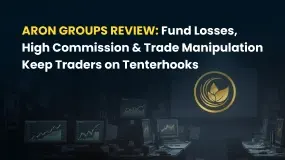简体中文
繁體中文
English
Pусский
日本語
ภาษาไทย
Tiếng Việt
Bahasa Indonesia
Español
हिन्दी
Filippiiniläinen
Français
Deutsch
Português
Türkçe
한국어
العربية
10 Common Issues In Technical Analysis In Forex Trading: 10 Rules To Overcome
Abstract:Unravel 10 common issues faced in Forex technical analysis and discover actionable rules to overcome them. Refine strategies, avoid pitfalls, and succeed in trading.

Forex trading is a dynamic field where technical analysis plays a pivotal role in guiding traders' decisions. However, navigating through its intricacies isn't always straightforward. This article highlights ten common issues that Forex traders often grapple with while using technical analysis. Ranging from over-reliance on indicators to misreading chart patterns, these challenges can pose significant obstacles. But fret not; for every problem, there's a solution. Along with pinpointing these issues, the article also provides ten actionable rules to help traders overcome them. Armed with this knowledge, traders can refine their strategies, sidestep common pitfalls, and pave the way for success in Forex trading.
Over-reliance on Technical Indicators

Understanding the limitations of indicators: Technical indicators are a double-edged sword. While they provide insights into market movements, they are retrospective by nature. This means they show what has already happened, not necessarily what will happen.
Avoiding “analysis paralysis” with too many indicators: With countless indicators available, traders might clutter their screens, leading to confusion and indecision. Using numerous indicators can sometimes yield conflicting signals, complicating the decision-making process.
Rules To Overcome: Simplify your trading strategy and avoid redundancy. Choose a set of reliable indicators that complement each other, eliminating the need for overlapping data.
Misinterpreting Chart Patterns

Understanding the limitations of indicators: Chart patterns can be subjective. A head-and-shoulders pattern to one trader might seem like a mere consolidation to another.
Avoiding “analysis paralysis” with too many indicators: Just as with technical indicators, overloading charts with various patterns can muddy analysis clarity.
Rules To Overcome: Wait for confirmation and use multiple timeframes. A pattern that appears on a 1-hour chart may be validated or invalidated by viewing it on a 4-hour or daily chart.
Ignoring Fundamental Analysis

The impact of economic events on technical setups: Technical setups can be disrupted by unforeseen economic events, from interest rate changes to political disruptions.
Balancing technical and fundamental perspectives: While technical analysis focuses on price action and patterns, fundamental analysis delves into economic conditions and news.
Rules To Overcome: Stay informed with an economic calendar and adapt to market conditions. Blend both forms of analysis for a well-rounded trading approach.
Failure to Recognize Trend Strength

Differentiating between strong and weak trends: Not all trends are created equal. Some have more momentum and can persist longer, while others may fizzle out quickly.
Understanding trend exhaustion signs: Towards the end of a trend, volume might decrease, and price movements may become erratic.
Rules To Overcome: Use volume and momentum indicators to gauge trend strength. Recognize signs of waning momentum and plan exits accordingly.
Over- or Underestimating Support and Resistance Levels

Identifying false breaches of key levels: At times, price might breach a support or resistance level, only to revert back. This 'fakeout' can trap unsuspecting traders.
Recognizing dynamic support and resistance: These levels aren't always static. Moving averages, for instance, can serve as dynamic support or resistance.
Rules To Overcome: Utilize horizontal and trendline tools, and remember past levels. Also, watch for consistent breaches to confirm new levels.
Improper Use of Timeframes

The pitfalls of switching timeframes without a plan: Jumping between timeframes without consistency can lead to mixed signals.
Understanding the “big picture” versus intraday movements: Larger timeframes capture broader market sentiments, while smaller ones hone in on daily fluctuations.
Rules To Overcome: Stick to a primary timeframe but always cross-reference. For instance, if trading on a 4-hour chart, check daily charts for broader context.
Not Accounting for Market Volatility

Recognizing volatility spikes and their causes: Volatility can arise from economic announcements, geopolitical events, or market sentiment shifts.
Adapting strategies for high volatility periods: High volatility can both be a risk and an opportunity.
Rules To Overcome: Use the Average True Range (ATR) and adapt stop loss placements. The ATR can help measure market volatility and adjust strategies accordingly.
Lack of Consistency in Applying Analysis

The danger of hopping between strategies: Switching between strategies without giving each an adequate test can lead to confusion and potential losses.
Avoiding confirmation bias in analysis: Traders sometimes see what they want to see, not what the charts are genuinely indicating.
Rules To Overcome: Develop a trading plan and stick to its criteria. Ensure you're not twisting analysis to fit a preconceived notion.
Ignoring Psychological Factors

Understanding crowd psychology and its impact on charts: Prices often move based on traders' collective emotions and psychology.
Overcoming personal biases and emotions: Trading out of fear or greed can lead to hasty decisions.
Rules To Overcome: Rely on objective data and maintain discipline. Keep emotions at bay and trust the analysis.
Risk Management Oversights

The importance of setting realistic stop losses and take profits: Protecting capital is as essential as seeking profit.
Balancing risk and reward in line with technical analysis: Every trade should consider potential profit against potential loss.
Rules To Overcome: Always predetermine risk levels and use risk-reward ratios effectively. This approach ensures longevity in the trading world.
Top 5 Frequently Asked Questions:

What are the key challenges in using technical indicators in Forex trading?
Traders often face the issue of over-relying on technical indicators. While these indicators offer valuable insights, they present data retrospectively, meaning they show past market movements. Additionally, the usage of multiple indicators can cause confusion and conflicting signals, leading to “analysis paralysis.”
How can a trader effectively interpret chart patterns in Forex trading?
Chart patterns can be subjective, leading to varying interpretations. To effectively interpret these patterns, it's crucial to wait for confirmation signals and cross-reference patterns across multiple timeframes, ensuring a consistent and more accurate reading.
Why is it essential to consider both technical and fundamental analysis in Forex trading?
While technical analysis offers insights based on price action and patterns, unforeseen economic events can disrupt these setups. Fundamental analysis helps traders understand the broader economic landscape, making it essential to blend both techniques for a comprehensive trading approach.
What is the significance of recognizing trend strength, and how can it impact trading decisions?
Recognizing the strength of a trend is essential as not all trends are consistent in momentum. By understanding signs of a weakening trend or its potential exhaustion, traders can make timely exit decisions and avoid potential losses.
How can traders ensure consistent and effective risk management in Forex trading?
Effective risk management involves setting realistic stop losses and take profits. It's crucial to balance potential profits against potential losses using risk-reward ratios, ensuring the longevity and sustainability of one's trading career.
Bottom Line:
In the world of Forex trading, mastering technical analysis is paramount. While there are ten common issues that traders might face, from the pitfalls of over-reliance on indicators to the intricacies of trend strength and risk management, each challenge presents an opportunity for growth. By acknowledging these challenges and implementing the ten accompanying rules, traders can navigate the Forex landscape with enhanced clarity and confidence. The journey might be intricate, but with the right tools and discipline, profitability and success are well within reach. Remember: every hurdle is a stepping stone towards becoming a more proficient trader.
To keep pace with the rapid changes in the Forex market and stay updated on the latest news, consider tools and apps like WikiFX. Download the App here: https://www.wikifx.com/en/download.html.

Disclaimer:
The views in this article only represent the author's personal views, and do not constitute investment advice on this platform. This platform does not guarantee the accuracy, completeness and timeliness of the information in the article, and will not be liable for any loss caused by the use of or reliance on the information in the article.
Related broker
Read more

Aron Groups Review: Fund Losses, High Commission & Trade Manipulation Keep Traders on Tenterhooks
Have you lost your hard-earned capital while trading via Aron Groups Broker? Has the high commission charged by the broker substantially reduced your trading profits? Does the Marshall Islands-based forex broker constantly manipulate spreads to widen your capital losses? Have you been lured into trading courtesy of Aron Groups No Deposit Bonus, only to find that you had to deposit capital to get a bonus? All these and many more trading issues have become synonymous with the experience of Aron Groups’ traders. Consequently, many traders have shared negative Aron Groups reviews online. In this article, we have shared some of their reviews.

Uniglobe Markets Bonus Review: Understanding the Offers and Uncovering the Risks
Many traders start looking for a new broker by searching for special deals and bonuses. The phrase "Uniglobe Markets no deposit bonus" is something people often search for. Let's address this question clearly and directly. Based on all the information we have, Uniglobe Markets does not currently offer a no-deposit bonus. Instead, this broker focuses on bonuses that require you to deposit your own money first. To get any bonus credits, traders must put in their own capital. Read on to learn how this entire bonus works out for traders.

PINAKINE Broker India Review 2025: A Complete Guide to Safety and Services
As online trading grows in popularity, Indian traders are always looking for brokers that offer good deals and fair conditions. PINAKINE has become one of these companies, getting attention by promising high leverage and many different account options. This broker, officially called Pinakine Liquidity Limited, has been operating for about one to two years and has made many people curious. Traders want to know the answer to the most important question: Is PINAKINE a real and safe place to invest money, or are there hidden dangers behind its attractive offers? Read on to know the answer.

Trading Oscillators: The Secret Tool Every Trader Should Know
If you’ve ever looked at a trading chart and wondered how traders know when a price is “too high” or “too low,” the answer often lies in trading oscillators. A trading oscillator is a type of technical indicator that helps traders measure the momentum of price movements. In simple terms, it tells you when a currency pair, stock, or commodity might be overbought or oversold — which can signal a potential reversal.
WikiFX Broker
Latest News
Is Nash Markets Regulated or Risk? Truth About Nash Markets’ License & Withdrawal Issues
Webull Widens Crypto Futures with Coinbase Derivatives
Latest FCA Daily Alerts and Consumer Warnings for 2025
CySEC Blocks Certification Access to Combat Advisor Impersonation
Angel one 2025 Review & Complaints
Exclusive Markets Under the Scanner: Traders Report High Swap Charges, Deposit Discrepancies & More
Voices of the Golden Insight Award Jury - Simon So, Chief Experience Officer of Hantec Financial
PINAKINE Broker Review: A Complete Look at Its Services and Risks
Pinched By Penny Shortage, US Retailers Beg Congress To Step In
PINAKINE Broker India Review 2025: A Complete Guide to Safety and Services
Currency Calculator




